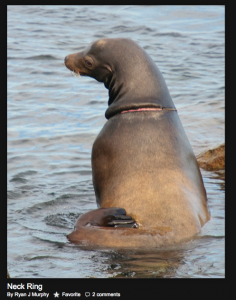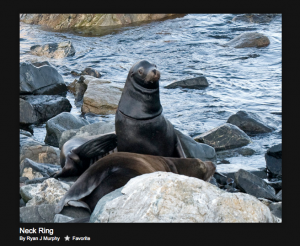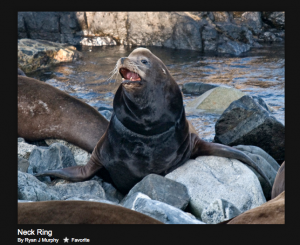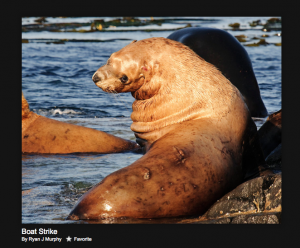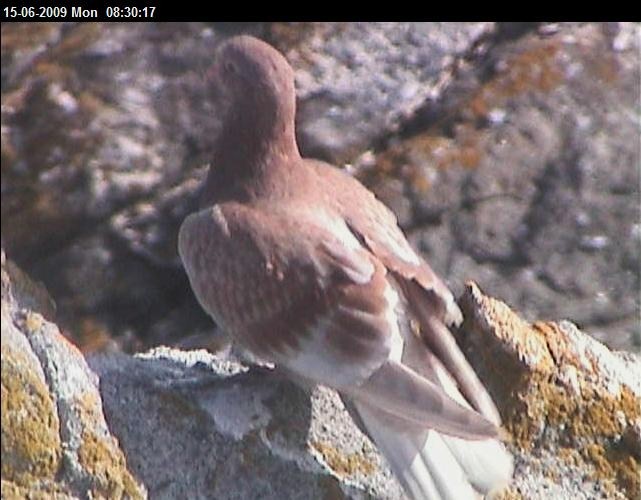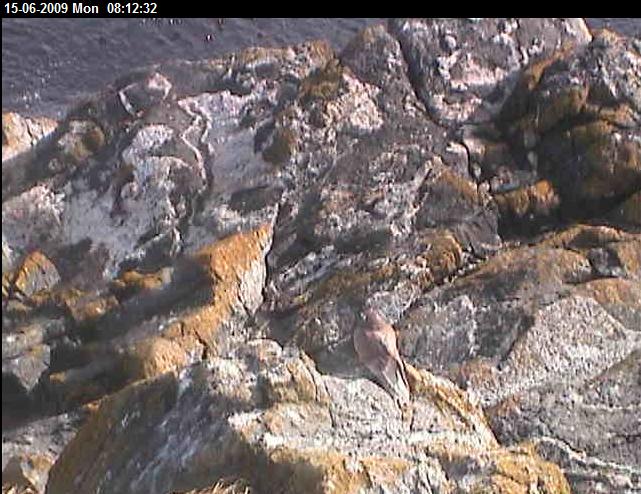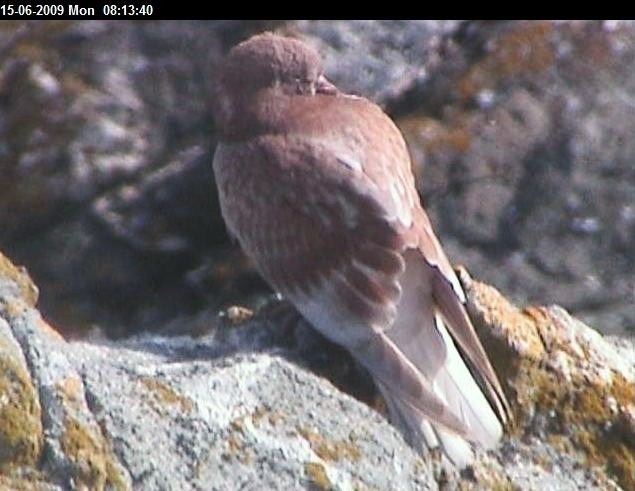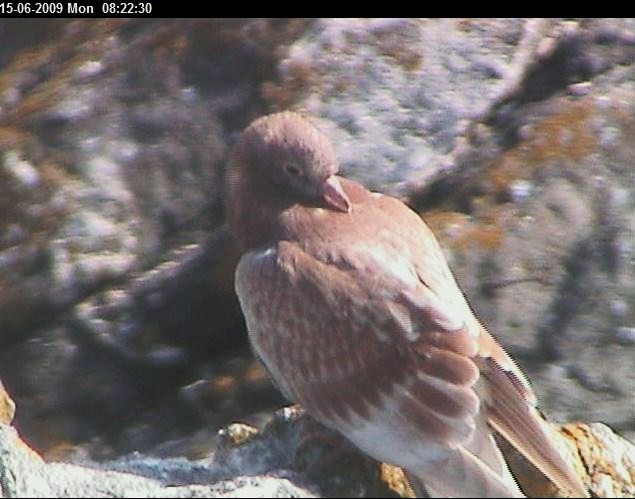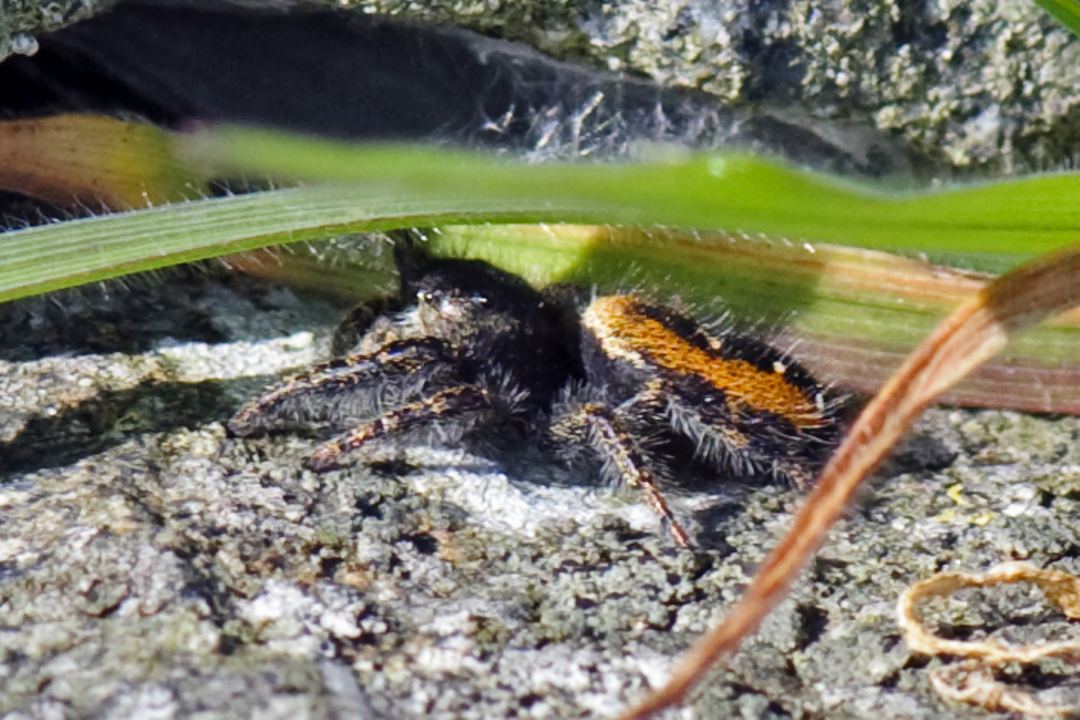Ryan recorded them with images on his Flickr site:
California and Northern Sea Lion injuries
Aside
See this link to the log pages with injured marine mammals.
Ryan has recorded the injuries with images on his Flickr site:
More solar panels installed
Orcas were spotted along the boundary of the reserve at several points throughout the day today.Our little friend the injured elephant seal has not been seen for several days now. However, the other young seal, possibly a male, was hauled up on the jetty last night.The number of sea lions continues to grow, as does the reach of their haul outs. A particularly stubborn and rather aggressive fellow was inhabiting the jetty this afternoon.Seagull chicks are beginning to lift off. Unfortunately, many are being found to have met their demise at the hands of the river otter which seems to frequent the island regularly these days.Two contractors from Home Energy Solutions in Victoria were here today to install new solar panels. Adam, 22:41:06.
Rear flipper cut off
Aside
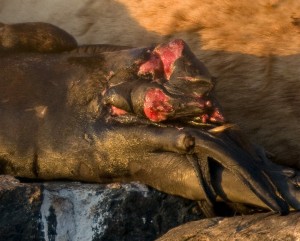 This fall there seems to be an unusual amount of injuries showing up on the sea lions,Ryan recorded them with images on his Flickr site:
This fall there seems to be an unusual amount of injuries showing up on the sea lions,Ryan recorded them with images on his Flickr site:
Seagull chicks starting to lift off ground
The baby elephant seal is present outside the concrete pad again today. Its back is covered in small wounds and every move it takes seems to be an effort. It spent all day sleeping beside the jetty. Wondering if it is sick or in poor health..The number of sea lions (both stellar and California) is growing daily. Most are hauled out on the NE corner of Gr. Race and on Middle Rock. Some are also on the southern rocks as well. A flock of four Canada Geese was present on the island for a few hours this morning. Seagull chicks are still growing, with many spreading their wings and starting to lift off from the ground. Carcasses in various stages of decomposition have been found scattered across the island this week, with two new ones beside the cistern spotted yesterday. Slash has not been seen for a week now. A number of infractions from recreational boats occurred today, including viewing animals from less than 100 metres, fishing and traveling at speeds greater than 7 kts. Recreational boaters are reminded that violation of the Marine Mammal Regulations (rev. 2006) may constitute a fine up to $100 000. Adam, 21:25:22
California Sea lions return
The seagull chicks are growing. I haven’t seen any new chicks in the last week or two, which leads me to believe that everyone has now hatched. None of the young have started to fly yet (as far as I have seen), but many of the chicks appear now to at least realise that the protrusions from their bodies may someday put them in the air. It is quite entertaining to watch the chicks hop up and down and flap their wings before falling on their heads! I haven’t seen our family of young geese now for a week or so. I suspect that they have outgrown the island and moved off. This week though we did have two stopovers from geese flocks. The first flock consisted of seven individuals while the second had twelve. Each flock landed for a few hours then left.Slash, as always, is still lazing around in the sun on the island. We did have Beatrice return a few weeks ago, but she only stayed for a day or two. I haven’t seen any more elephant seals these days. Four or five California sea lions have returned to the reserve. Several are currently hauled out on Middle Rock, and several more are hauled out on the northeast corner of Great Race Rock. Unfortunately, they appear to be quite the attraction for whale watching tourists.Many pigeon guillemots are still present across the island, as well as a number of black oystercatchers that can often be seen out on the jetty at night when I do the water sampling.Life underwater is also flourishing, as expected. Yesterday I did two dives off the north side of the island and saw the normal plethora of creatures. Many of my fellow divers also spotted a wolf eel lurking in the upper reef. I unfortunately, missed it.Pam has also reported seeing an otter skulking around too. I’ve been on and off the island in the last week quite a bit, so I guess I must have missed it. -Adam- ’21:27:09′,
Visitors to Race Rocks
Glen Rasmussen, of the DFO Nanaimo office and a group of his counterparts from New Zealand made a trip with Garry and Chris to Race Rocks.
Oystercatcher chicks
‘The painters today spotted twelve orcas including babies swimming through the reserve. A possibly dead elephant seal was noticed washed up in the intertidal -but still partially submerged) this morning. Black oystercatchers have chicks! In the S surge channel beneath the science house, two chicks were noticed with a parent. They are still very small. The three baby geese are growing still. Every day they are growing stronger and venturing further and further from their parents. There is an old goose on the SE side of the keeper”s house that is looking very frail -this has been going on for a while now). I would expect that it is on its last legs.’, ‘Adam’, ’12:29:50 ,
Columba livia: Rock Dove–The Race Rocks Taxonomy
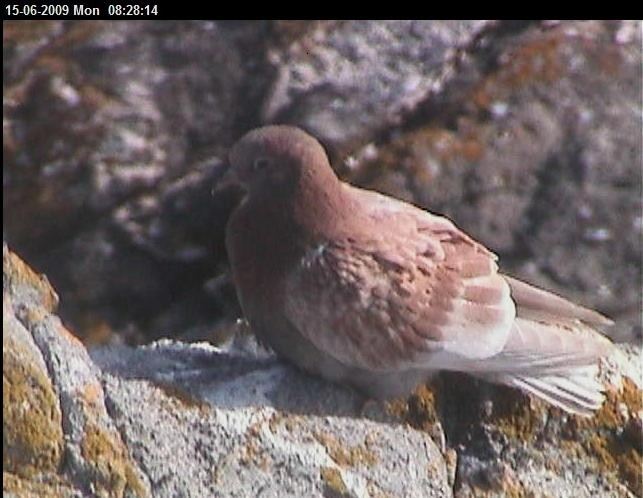
Columba livia at Race Rocks
Surprisingly this is the first pigeon we have seen at Race Rocks The week this photo was taken on the remote camera by Pam Birley, it has been non-stop winds from the West over 25km/hr. Perhaps it was just blown away from its normal flock.
Note: Moisture and heat retention by breathing under the wings. This pigeon It appeared on June 15,2009.Most of the pigeons we see around Victoria are the typical grey body with dark bands
Domain Eukarya
Kingdom Animalia
Phylum Chordata
SubphylumVertebrata
Class Aves
Order Columbiformes
Family Columbinae
SubfamilyColumbinae
Genus Columba
Species livia
Linnaeus, 1758
Common Name: Rock Dove, Rock Pigeon
| Other Members of the Class Aves at Race Rocks |
and Image File |
 The Race Rocks taxonomy is a collaborative venture originally started with the Biology and Environmental Systems students of Lester Pearson College UWC. It now also has contributions added by Faculty, Staff, Volunteers and Observers on the remote control webcams. The Race Rocks taxonomy is a collaborative venture originally started with the Biology and Environmental Systems students of Lester Pearson College UWC. It now also has contributions added by Faculty, Staff, Volunteers and Observers on the remote control webcams.
Pam Birley |
Phidippus borealis: Red-backed Jumping spider–The race Rocks Taxonomy
| Phidippus borealis at Race Rocks, March 11, 2010. |
| This is our first photo of this spider , taken by Ryan Murphy |
“The spider I noticed from about 20m away! It’s about 2.5 cm (1 inch) long and the bright orange pattern with white spots was really shocking. It’s made a funnel web in the rocks near the house, a really interesting structure of woven grass.” RM
Domain Eukarya
Kingdom Animalia
Phylum Arthropoda
Class Arachnida
Order Araneae
Sub-order Araneomorphae
Family Salticidae
Subfamily Dendryphantinae
Genus Phidippus
Species borealis
Common Name: Red-backed Jumping spide
| Other Members of the Phylum Arthropoda at Race Rocks |
and Image File |
 The Race Rocks taxonomy is a collaborative venture originally started with the Biology and Environmental Systems students of Lester Pearson College UWC. It now also has contributions added by Faculty, Staff, Volunteers and Observers on the remote control webcams. The Race Rocks taxonomy is a collaborative venture originally started with the Biology and Environmental Systems students of Lester Pearson College UWC. It now also has contributions added by Faculty, Staff, Volunteers and Observers on the remote control webcams.
Ryan Murphy(PC) |

